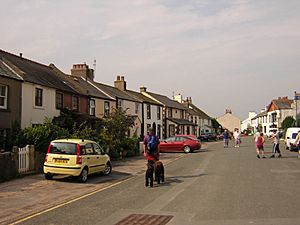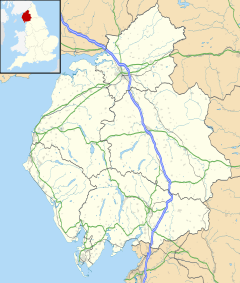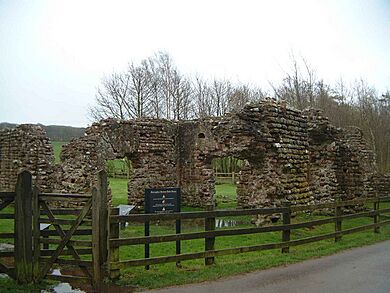Ravenglass facts for kids
Quick facts for kids Ravenglass |
|
|---|---|
| Village | |
 View up Main Street |
|
| OS grid reference | SD0896 |
| Civil parish |
|
| Unitary authority |
|
| Ceremonial county | |
| Region | |
| Country | England |
| Sovereign state | United Kingdom |
| Post town | Ravenglass |
| Postcode district | CA18 |
| Dialling code | 01229 |
| Police | Cumbria |
| Fire | Cumbria |
| Ambulance | North West |
| EU Parliament | North West England |
| UK Parliament |
|
Ravenglass is a small village located right by the sea in England. It sits between the towns of Barrow-in-Furness and Whitehaven. Here, three rivers – the Esk, Mite, and Irt – flow into the sea. Ravenglass is unique because it's the only village on the coast that is part of the amazing Lake District National Park. It's now part of Cumbria, a county in North West England.
Contents
Discovering Ravenglass's Past
Ravenglass has a very long history, going back at least to the 2nd century. Back then, it was a super important naval base for the Romans. For a long time, people thought the Roman name for this place was Glannoventa.
Roman Secrets Uncovered
In the 1970s, during some digging at the old Roman fort, a lead seal was found. This seal had the name Cohors Prima Aelia Classica on it. This was a special group of Hadrian's Marines. This same group was listed in an old Roman document as being stationed at a place called Itunocelum. Because of this discovery, experts now believe that Ravenglass was actually Itunocelum, not Glannoventa.
More proof has been found since then. A Roman military document was found on the beach near the fort. Also, a piece of a Roman altar was discovered nearby. Both of these items also mention the Cohors Prima Aelia Classica. This makes it almost certain that Ravenglass was indeed the Roman Itunocelum.
A Roman Frontier Outpost
The Roman fort at Ravenglass was the most southern point of the Roman coastal defense system in Cumbria. Think of it as an extension of Hadrian's Wall, protecting the western edge of the Roman Empire. The Romans stayed in Ravenglass for over 300 years. They had a garrison of 500 soldiers living there.
Ravenglass was a key supply point for much of Roman Britain's northwest region. A Roman road even went from Ravenglass, over the tough Hardknott Pass, to other Roman forts.
What Remains Today?
Today, not many Roman structures are left. But there is one amazing exception: a bath house, which locals call Walls Castle. This is one of the biggest Roman buildings still standing in England! It was once huge, about 30 meters long and 13 meters wide. Its walls were up to 3.6 meters high. Now, you can only see one end of it. The rest of the foundations are covered up. English Heritage now looks after this important historical site.
About a mile from the bath house is Muncaster Castle. People believe that parts of this castle were built using stones from a Roman fort that was once near Ravenglass.
Medieval Times in Ravenglass
The name 'Renglas' appeared in old documents around the late 1100s. In 1208, King John gave permission for Ravenglass to have a market every Saturday. It also had a yearly fair on August 5th. By 1297, Ravenglass was known as an important port, just like Lancaster and Workington.
Some people even say that Saint Patrick, a famous saint, was born in Ravenglass!
What Does "Ravenglass" Mean?
The name Ravenglass has a few possible meanings. One idea is that it comes from a Welsh phrase, yr afon glas, which means "the greenish or bluish river." Another idea is that it comes from an old Norse-Irish name, meaning "Glas's part or share." It could also mean "small stream" in Gaelic. Some even suggest it comes from an Old Norse name, Hrafnkell, combined with óss, meaning "estuary" or "river mouth."
Fun Things to Do in Ravenglass
Ravenglass is a great place for visitors! Two popular attractions are Muncaster Castle and the Ravenglass and Eskdale Railway.
Getting Around Ravenglass
Train Travel
Ravenglass has its own train station, Ravenglass railway station. This station is on the Cumbrian Coast Line, which connects to towns like Carlisle and Lancaster.
The station is also where the special narrow-gauge Ravenglass and Eskdale Railway starts. This small train line goes inland up the beautiful Eskdale valley. It's a fun tourist attraction, but it also helps people get around during its operating season.
Roads and Paths
A small road connects Ravenglass to the main A595 highway. There are also small tracks that go north and south. However, these tracks cross areas that are covered by the tide, so they are not suitable for regular cars.
Ravenglass in Stories
Ravenglass has even appeared in books! The area of Eskdale and Rafnglass (which is modern Ravenglass) is featured in Sword Song, a novel by Rosemary Sutcliff from 1992. This story is set in the 9th century. Also, a TV show from 1972 called The Intruder was mostly filmed in Ravenglass. In the show, Ravenglass was called "Skirlston."



